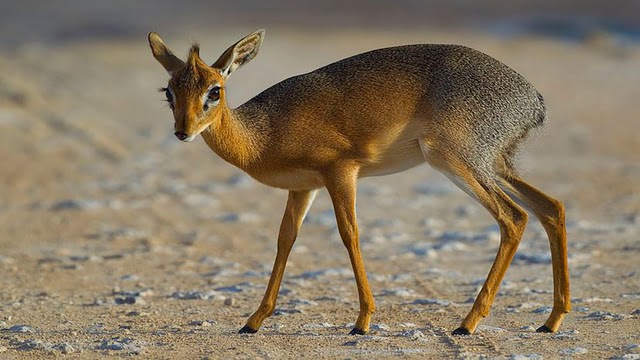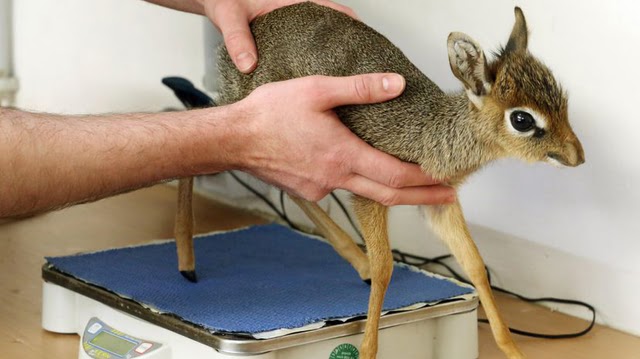Quck answer
Dik-dik is a small antelope that lives in savannas, woodlands, and bushlands of eastern and southern Africa. They are named after the sound they make when alarmed, which is a high-pitched whistle. Dik-diks are about 30 centimeters tall and weigh around 6 kilograms. They have large, dark eyes and elongated snouts that help them smell predators. Dik-diks are monogamous and form strong bonds with their partners. They are herbivores and feed on leaves, shoots, and fruits. Despite their cute appearance, dik-diks are preyed upon by numerous predators, including lions, leopards, and hyenas.
Wild Animals

This female Kirk’s dik-dik (Madoqua kirkii) resides in Etosha National Park, Namibia, Africa. Wikimedia Commons (CC BY-SA 3.0)
Africa is home to a variety of antelope species. Most of them, such as wildebeests, gazelles, and impalas, are large, striking, and majestic. However, the dik-diks (genus Modoqua) are different. These small antelopes usually weigh between 7 and 18 pounds (3 and 7 kilograms) and grow to be just 14 to 18 inches tall (35 to 45 centimeters) when fully grown. Despite their diminutive size, they are incredibly cute.
What are Dik-diks?
Four species of dik-diks can be found throughout Africa, primarily in dry, semi-desert areas. Gunther’s dik-diks live in the arid regions of East Africa, while Kirk’s dik-diks inhabit eastern and southwestern Africa. Silver dik-diks live in the low, dense thickets of Somalia’s southeastern coast and southeastern Ethiopia. Salt’s dik-diks are found in northern Kenya and eastern Sudan. Each of these species has numerous subspecies.
The Brookfield Zoo in Brookfield, Illinois, just north of Chicago, is home to four dik-diks – one male and three females. Amy Roberts, senior curator of mammals at the zoo, spoke with us about these tiny antelopes.
The dik-dik’s Bambi-like face is dominated by its prominent snout and dark eyes ringed with white markings. A black preorbital gland about the size of a pencil eraser looks like a dot at the corner of each eye. The gland secretes a black tarry substance that the dik-dik uses to mark its territory.
“In professional care and in their natural habitat, the dik-dik will go up to a branch and appear as if they’re putting a branch in their eye,” says Roberts. “They flick their head back and forth, leaving the black substance that hardens to mark their territory. In the zoo world, some of the females will even attempt to mark their keepers. I’ve worked with springers and dik-diks who’ve marked my kneecaps.”
Dik-dik Breeding
Dik-diks live in monogamous pairs, not in herds. Males can be easily identified by their short, 3-inch (8-centimeter) horns. Females usually give birth to two offspring per year, with gestation lasting five to six months. Once the elder offspring is of full size, about seven months, the parents encourage it to leave the territory.
According to Roberts, the size of the territory can vary greatly, depending on the quality of the environment and the number of dik-diks the territory needs to support.
“There’s almost always going to be a pair with one offspring, and if you have a new offspring, they’ll drive the older one out,” she says. “If there’s a lot of cover and greenery available, they’ll have a smaller range. But if it’s a sparser environment with fewer places to hide with less food to eat they’ll need a much bigger area.”

A 13-day-old Salt’s dik-dik (Madoqua saltiana) walks off a scale at the zoo in Duisburg, Germany, where it was born in 2015 and rejected by its mother.
ROLAND WEIHRAUCH/DPA/AFP/Getty Images
What Do Dik-diks Eat?
Dik-diks are herbivores that browse rather than graze, primarily eating the leaves of acacia trees and shrubs. They take advantage of their small size by feeding on seeds or flowers dropped by larger animals. In captivity, Roberts says they’re fed alfalfa pellets enriched with vitamins and minerals.
According to Roberts, dik-diks are fed pellets, alfalfa hay, and browse, which are cut branches with fresh leaves. These skittish animals get their name from the “z” sound they make when frightened. Their pliable snout is a highly evolved cooling system that cools the blood before it goes to the brain. They don’t require much water to survive and have high functioning kidneys. Although dik-diks are tiny, they are not domesticated and would not make good house pets. They have slender legs that would be prone to breaking on hardwood or linoleum. Dik-diks are monogamous and need an appropriate social grouping. Roberts loves to work with smaller antelopes and dik-diks are one of her favorites. Even though dik-diks are not endangered, they are hunted for their hides, which are often made into gloves. One hide is equivalent to one glove.
FAQ
1. What is a dik-dik?
A dik-dik is a small antelope species that inhabits eastern and southern Africa. They are known for their petite size, standing at only around 30 cm tall and weighing between 3-6 kg. They have a unique appearance with a reddish-brown coat, elongated snout, large eyes, and tiny horns that only males possess.
2. Why are they called dik-diks?
The name “dik-dik” comes from the sound they make when they sense danger. They have a high-pitched whistle that sounds like “dik-dik” or “zik-zik,” which serves as a warning to other dik-diks in the area. Despite the somewhat embarrassing name, dik-diks are fascinating animals with many unique traits.
3. What do dik-diks eat?
Dik-diks are herbivores and primarily feed on leaves, shoots, fruits, and flowers. They have a specialized digestive system that allows them to extract as much moisture as possible from their food, which is important in the dry climates where they live.
4. Are dik-diks endangered?
While some species of antelope are endangered, dik-diks are not currently considered to be threatened. They are adaptable and resilient animals that can survive in a variety of habitats, including savannas, woodlands, and deserts.
5. Do dik-diks make good pets?
No, dik-diks do not make good pets. They are wild animals that require a specific diet and environment to thrive. Keeping a dik-dik as a pet is illegal in many countries, and it is not ethical to remove them from their natural habitat. It is best to admire these unique animals from a distance in their natural habitat or in a reputable zoo.





Leave a Reply